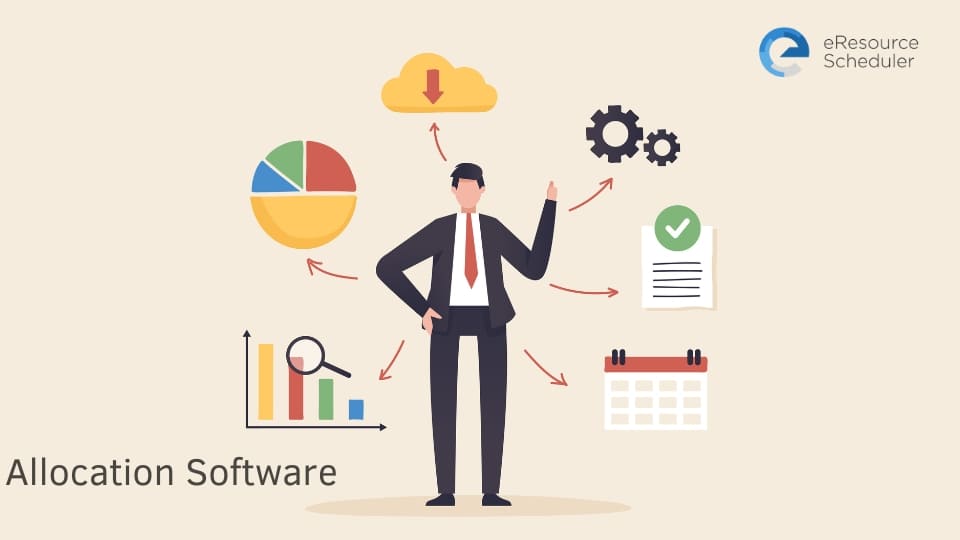
With the rapidly evolving business world and globally volatile economic conditions, it is important to understand the business model that could make higher profits and expansion possible. One of the noteworthy trends in recent years has been the decentralization of business processes in organizations as many tasks are being increasingly outsourced. Moreover, the pandemic in 2020 impelled more and more businesses to adopt remote working and distributed teams, embrace flexible scheduling, and move towards decentralizing their organizational structure. Having said that, it’s important to explore if decentralization is the answer and what its advantages and disadvantages are. It’s also important to understand how an organization can move away from or transform its centralized structure. The answer lies in implementing the right allocation software. Resource allocation Software can help you achieve this feat while offering a lot of other benefits. Read on to find out more.
Imagine a scenario where all your employees, resources, databases, and finances are under one roof. You can just plan, get everyone together, and execute the work. But how do you manage remote or distributed teams? The same approach is not going to work. It isn’t a cakewalk to get approval for a specific project from all its key stakeholders and decision-makers. They could all work at their own pace and have different priorities, which could lead to delays and a lot of frustration. Even if a project is kicked-off, poor communication and lack of collaboration among the key actors will definitely derail it. This is why keeping all resources and stakeholders in sync is imperative to build a decentralized organization. But before proceeding further, let’s understand what is meant by a decentralized organization.
Decentralization in an organization refers to a structural arrangement where decision-making authority is dispersed across the entire company, contrasting with the concentrated approach of traditional hierarchical systems. In centralized structures, pivotal decisions emanate from the upper echelons, primarily the C-suite, ensuring uniformity and oversight. Nonetheless, this centralized model can inadvertently lead to decision bottlenecks, hampered agility, and stifled innovation.
Conversely, a decentralized organization distributes decision-making power amongst teams and divisions closer to the frontline, fostering swifter decision-making, adaptability, and nimbleness. This approach also tends to amplify customer-centric practices. In political discourse, this concept aligns with ‘subsidiarity,’ advocating that central entities should focus solely on tasks beyond local capabilities. However, it's essential to note that decentralization doesn't imply disarray; rather, it signifies a structured framework. This structure is flatter and pruned of superfluous bureaucratic layers, enabling a more efficient and responsive operational paradigm.
In the dynamic landscape of modern business, the concept of decentralization has gained substantial prominence as a strategic approach for organizational management. This paradigm shift challenges the traditional centralized structure, offering a plethora of advantages that can significantly impact a company's growth trajectory. From improved decision-making to enhanced innovation, decentralization has proven to be a game-changer for businesses looking to thrive in today's competitive environment. It becomes even easier to decentralize your business using resource allocation tools . Let's delve into the key advantages of decentralization for business and how it can drive success.

Decentralization grants organizations the agility and flexibility needed to quickly adapt to changing market conditions. In a centralized structure, decisions often trickle down a hierarchical chain, causing delays and hindering quick responses. Decentralization empowers individual departments or units to make autonomous decisions, enabling the organization to pivot, innovate, and seize opportunities promptly. This flexibility is particularly crucial in industries characterized by rapid technological advancements and evolving customer preferences.
Centralized decision-making can lead to bottlenecks, as important choices require approval from higher levels of management. Decentralization disperses decision-making authority, allowing front-line teams to make decisions aligned with their expertise and knowledge. This expedites the decision-making process, eliminates bureaucratic hurdles, and fosters a culture of prompt action and accountability. An allocation software comes in handy for making well-thought-out decisions that are backed by data.
Decentralization places decision-making power closer to the employees who possess the relevant information and expertise. This empowerment instills a sense of ownership and accountability among team members. When individuals have a stake in the outcomes of their decisions, they are more likely to take initiative, innovate, and ensure successful execution.
In a decentralized environment, diverse teams have the autonomy to experiment and explore new ideas. This sparks creativity and innovation at all levels of the organization. By tapping into the collective intelligence of employees across departments, businesses can generate novel solutions, products, and services that cater to evolving market demands.
Decentralization allows for a more personalized and customer-centric approach. Front-line teams interacting directly with customers can tailor their strategies to meet their unique needs and preferences. This customer-focused approach enhances customer satisfaction, loyalty, and retention rates. An allocation software makes customer-centricity your key focus while helping you deliver top-quality projects.
Decentralization promotes professional growth and development. When employees are entrusted with decision-making authority, they gain valuable experience and skills that contribute to their career advancement. This, in turn, enhances employee morale, job satisfaction, and overall retention rates.
Decentralization can lead to efficient resource allocation. Each unit or department can assess its needs and allocate resources accordingly, reducing redundancies and wastage. This streamlined resource allocation optimizes operational efficiency and cost-effectiveness. An allocation software helps to automate various redundant tasks, thus reducing processing time and costs.
Decentralization taps into the specialized knowledge and expertise present within different units of an organization. This enables each unit to make decisions that are contextually relevant and aligned with local market conditions. Harnessing localized insights can lead to better strategic planning and execution.
Decentralized organizations often exhibit greater resilience during times of crisis. With decision-making distributed across multiple levels, the organization can respond more effectively to unexpected challenges. The ability to make swift decisions based on real-time information is a valuable asset in navigating turbulent times.
Decentralization fosters a culture of inclusion, where employees feel their contributions are valued and their voices are heard. This heightened sense of engagement and morale can lead to increased job satisfaction, stronger teamwork, and a more positive work environment. The right allocation software helps to foster communication and collaboration for your employees, which further enables sharing data, feedback, and approvals much easily. This, in turn, encourages an open and healthy work environment which boosts employee morale.
Optimizing resource allocation is a critical aspect of effective project management that can significantly impact an organization's success. To ensure that resources are utilized efficiently, companies need to establish streamlined processes and utilize advanced tools. How do you do that? Let’s delve into the various dimensions of resource allocation and look at the advantages of employing centralized allocation software.
Efficient resource work allocation necessitates a centralized system that allows supervisors to monitor resource utilization and availability. This centralization is a pivotal feature of resource allocation software, as it facilitates the seamless assignment of resources to tasks. A resource allocation tool offers real-time visibility into resource capacity, availability, and utilization, which is essential for making effective resource allocation decisions. For example, tracking the availability of resources can be achieved through metrics like available hours, busy hours, and the percentage of free time. Implementing colour coding, where colours denote availability status, further enhances resource management. Although recording time schedules or tracking time requires only a few minutes from team members, this data significantly contributes to calculating actual billable hours and utilization rates. Comparing these figures with projected availability provides valuable insights into the accuracy of forecasts and a resource allocation software can easily do that for you.
A crucial step in successful resource allocation is the creation of a detailed project plan. Breaking down projects into smaller tasks and sub-tasks, known as a Work Breakdown Structure (WBS), is the foundation of effective resource allocation. This process enables the identification of tasks that can run concurrently and those that are interdependent. Establishing a critical path within each project reveals the minimum time required for project completion. Resource allocation is integral to this process, as it involves assigning individuals to tasks based on their skills and availability. Utilizing dedicated allocation software simplifies this process, enhancing project planning accuracy.
A diverse team usually comprises members with varying levels of drive and responsibility. Effective project managers are tasked with overseeing multiple tasks within the constraints of time and cost. To ensure optimal productivity, it is imperative to monitor team members' time utilization on a daily, weekly, and monthly basis. An allocation software with an in-built time management solution plays a pivotal role in this context. This tool provides real-time insights into employee activities and raises alerts for excessive time spent on non-productive tasks. These insights help establish clear priorities and facilitate adherence to project timelines.
Identifying the right individuals with the appropriate skill sets for new projects can be challenging. Imagine having a centralized skills repository that lists all resources along with comprehensive details of their competencies, experience, and core expertise. A skills repository is essentially a compilation of required skill sets for various projects. A resource management software with a centralized skills repository simplifies the process of selecting and assigning suitable team members to projects. In large organizations with distributed teams, managing this repository can be complex. A dedicated allocation software streamlines this task by offering a central online resource list complete with availability, skills, and expertise details. Consequently, selecting the right resource becomes a streamlined and efficient process.
An allocation software consolidates critical resource data from disparate systems into a centralized online platform. This comprehensive visibility empowers project managers to assign suitable resources to different projects. The selection process involves considering skills, experience, qualifications, costs, availability, and other relevant criteria. A notable approach to resource allocation is selecting the best-visible-best-fit resources. This strategy, enabled by the enhanced visibility provided by the software, allows managers to distribute highly skilled resources across various projects rather than reserving them exclusively for high-priority tasks.
Effective resource utilization is essential for achieving profitability and success in project execution. Inefficient utilization of employees, machinery, or finances can result in unnecessary expenses and potential losses. Optimal resource utilization is particularly crucial for strategic or high-value resources, as they tend to be limited and expensive. An allocation software equipped with resource utilization capabilities is an invaluable asset in this regard. By ensuring a balanced workload and optimal allocation, the software contributes to improved productivity and the timely completion of projects.
In conclusion, resource allocation is a multifaceted process crucial to project management success. By adopting a centralized resource allocation software like eResource Scheduler, businesses can gain real-time insights into resource availability, create comprehensive project plans, track team time efficiently, maintain a detailed skills repository, find and allocate the best-fit resources, and optimize resource utilization. Through strategic resource allocation practices and cutting-edge tools, organizations can achieve heightened efficiency, cost-effectiveness, and overall project success.
For organizations aiming to streamline resource allocation and project management, eResource Scheduler stands out as a robust cloud-based solution. This top-rated resource allocation software offers features such as an intuitive interface, drag-and-drop functionality, detailed reporting, time tracking, and a centralized repository of global resources and projects. eResource Scheduler empowers project managers with real-time visibility, enabling proactive planning and efficient allocation. With this allocation software, organizations can seamlessly allocate, schedule, and manage resources, resulting in enhanced productivity and successful project outcomes.
The tool can also help with making accurate schedules, estimating resource utilization, and productivity management. eResource Scheduler provides real-time visibility that enables project managers to create flawless plans and find the right resources if there is any sudden requirement, short- or long-term. So, are you on a look-out for an allocation tool that does seamless project and resource management? Zero down on eResource Scheduler. To resolve any queries that you may have, get a free trial today and check out the tool’s features and benefits.
Plan Smarter. Schedule Faster.
Join thousands already using eResource Scheduler to align teams, time, and tasks seamlessly.